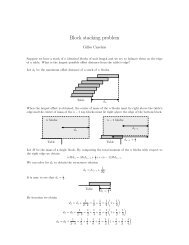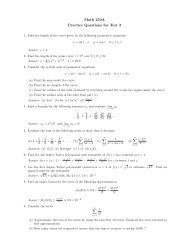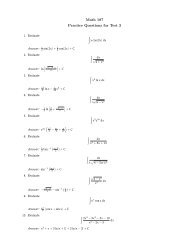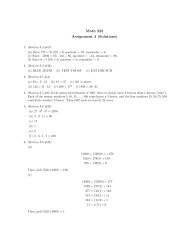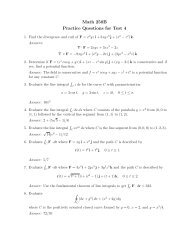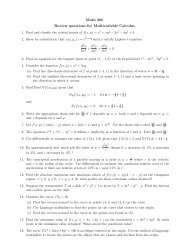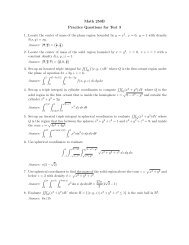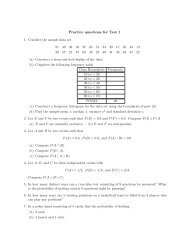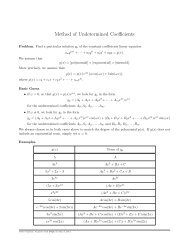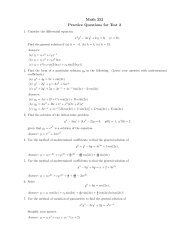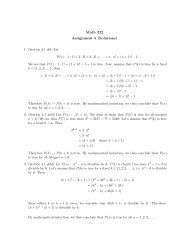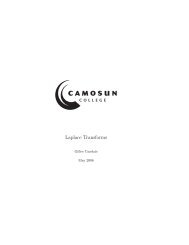Math 250B Study tips for the Final Exam
Math 250B Study tips for the Final Exam
Math 250B Study tips for the Final Exam
You also want an ePaper? Increase the reach of your titles
YUMPU automatically turns print PDFs into web optimized ePapers that Google loves.
<strong>Math</strong> <strong>250B</strong><strong>Study</strong> <strong>tips</strong> <strong>for</strong> <strong>the</strong> <strong>Final</strong> <strong>Exam</strong>1. 13.3 Make sure that you know how to take partial derivatives of any function.2. 13.4 You should know that if z = f(x, y), <strong>the</strong>n <strong>for</strong> “small” ∆x and ∆y we have∆z ≈ ∂f ∂f∆x +∂x ∂y ∆y.For Error Analysis questions, ∆z = absolute error, and ∆zz= relative error, which is often expressed asa percentage.For example, if z = 5.0 ± 0.1, <strong>the</strong>n ∆z = 0.1 and ∆zz = 0.15.0 = 2%.3. 13.5 Drawing a tree diagram can be helpful when we use <strong>the</strong> chain rule <strong>for</strong> functions of several variables.Instead of memorizing <strong>for</strong>mulas <strong>for</strong> implicit differentiation, it is much easier to draw a tree diagram.4. 13.6 The <strong>for</strong>mula <strong>for</strong> directional derivativeD u f(x, y) = ∇f(x, y) · uis only valid if u is a unit vector. Remember that if v is a nonzero vector, <strong>the</strong>n u =v‖v‖is a unit vectorthat points in <strong>the</strong> same direction as v.5. 13.6 Make sure you know <strong>the</strong> following properties of <strong>the</strong> gradient of f(x, y).(a) For all (x, y), <strong>the</strong> vector ∇f(x, y) points in <strong>the</strong> direction of maximum increase of f.(b) The maximum value of D u f(x, y) is ‖∇f(x, y)‖.(c) ∇f(x 0 , y 0 ) is a vector normal to <strong>the</strong> level curve f(x, y) = c at point (x 0 , y 0 ).6. 13.6 For <strong>the</strong> Heat-Seeking Particle example (p. 937), observe that <strong>the</strong> path of <strong>the</strong> particle is alwaystangent to ∇T . There<strong>for</strong>e, <strong>the</strong> slope of <strong>the</strong> tangent line of <strong>the</strong> path ( dydx) is always equal to <strong>the</strong> “slope”of <strong>the</strong> vector ∇T . We <strong>the</strong>n havedydx = T y.T x7. 13.7 You should know that if F (x, y, z) = c is a surface in space, <strong>the</strong>n at point (x 0 , y 0 , z 0 ) on <strong>the</strong> surface,<strong>the</strong> vectorN = ∇F (x 0 , y 0 , z 0 )is a vector normal to <strong>the</strong> surface. Once you know vector N and point (x 0 , y 0 , z 0 ), you can ei<strong>the</strong>r findequations <strong>for</strong> a tangent plane or a normal line.8. 13.7 To get a vector normal to a surface described as z = f(x, y). ConsiderF (x, y, z) = f(x, y) − zand think of <strong>the</strong> surface as F (x, y, z) = 0 so that ∇F gives a normal vector.9. 13.7 If (x 0 , y 0 , z 0 ) is a point on <strong>the</strong> curve of intersection of <strong>the</strong> two surfaces<strong>the</strong>n vectorF (x, y, z) = c and G(x, y, z) = d∇F (x 0 , y 0 , z 0 ) × ∇G(x 0 , y 0 , z 0 )is a vector tangent to <strong>the</strong> curve at point (x 0 , y 0 , z 0 ).
10. 13.8 You do not have to memorize it but make sure that you know how to use <strong>the</strong> Second PartialDerivative Test.11. 13.8 For problems asking <strong>for</strong> absolute extremum of a function over a closed, bounded region, rememberthat <strong>the</strong> absolute extremum can occur ei<strong>the</strong>r(a) at a critical point inside <strong>the</strong> region;(b) or at a boundary point of <strong>the</strong> region.12. 13.10 You should know how to use <strong>the</strong> method of Lagrange Multiplier <strong>for</strong> problems involving one or twoconstraints.13. 14.1 Make sure that you know <strong>the</strong> method of substitution and integration by parts since some integralsmight require it.14. 14.2 Make sure that you understand <strong>the</strong> process of reversing <strong>the</strong> order of integration <strong>for</strong> double integrals.See example 4, p. 996.15. 14.3 When we evaluate integrals in polar coordinates, we often encounter trigonometric integrals involvingsin θ and cos θ. Make sure that you know how to evaluate integrals such as∫∫sin 3 θ cos θ dθ or cos 2 θ dθ.16. 14.4 - 14.5 These sections include some important applications of Double Integrals. The <strong>for</strong>mulas <strong>for</strong>center of mass, moments of inertia, and surface area are on <strong>the</strong> <strong>for</strong>mula sheet.17. 14.6 The more difficult part with triple integrals is usually not <strong>the</strong> computation but setting-up <strong>the</strong> tripleintegral. I suggest to study example 4 (p. 1028) and to redo questions from practice test 2.18. 14.7 This section is very important. Converting a triple integral to cylinder coordinates is very similar toconverting a double integral to polar coordinates, simply note that <strong>the</strong> extra variable z remains unchanged.For spherical coordinates, I suggest to study example 4 (p. 1039) and look at <strong>the</strong> suggested problems fromthis section.19. 14.8 When you per<strong>for</strong>m a change of variables to evaluate a double integral, do not <strong>for</strong>get <strong>the</strong> Jacobian.20. 15.1 Make sure that you know how to test if a vector field is conservative and how to find a potentialfunction.21. 15.2 You should know how to evaluate line integrals ∫ C f(x, y, z) ds and ∫ F · dr <strong>for</strong> a piecewise smoothCcurve C of parametrization r(t), a ≤ t ≤ b.22. 15.3 For conservative fields, you should know <strong>the</strong> Fundamental Theorem of Line Integrals and <strong>the</strong>Independence of Path property.23. 15.4 You should know how to use Green’s <strong>the</strong>orem.24. 15.5 For a parametric surface given by r(u, v), <strong>the</strong> vector r u × r v is a vector normal to <strong>the</strong> surface and<strong>the</strong> element of surface area is dS = ||r u × r v || dA25. 15.6 You should know how to evaluate Surface Integrals and Flux Integrals.26. 15.7 - 15.8 You should know how to use both <strong>the</strong> Divergence and Stoke’s <strong>the</strong>orem . Since we were nottested on <strong>the</strong>se sections, I suggest to do <strong>the</strong> suggested homework problems from <strong>the</strong> book. You shouldalso look at <strong>Exam</strong>ple 1 from 15.7 (p. 1122) and <strong>Exam</strong>ple 1 from 15.8 (p. 1129).



